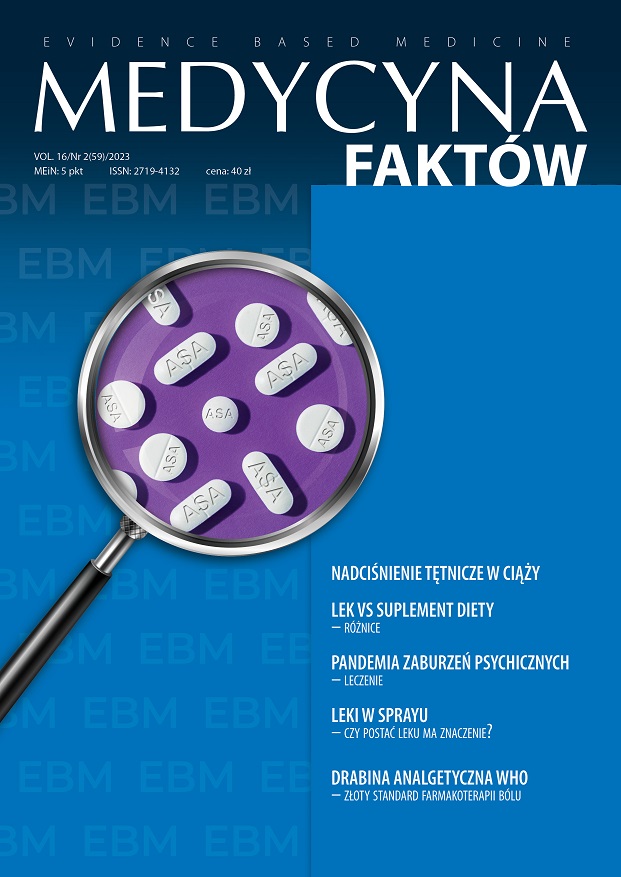Zastosowanie ASU w terapii choroby zwyrodnieniowej stawów Artykuł przeglądowy
##plugins.themes.bootstrap3.article.main##
Abstrakt
Choroba zwyrodnieniowa stawów (ChZS) związana jest z występowaniem przewlekłych dolegliwości bólowych oraz stanowi jedną z najczęstszych przyczyn niepełnosprawności na świecie. W ostatnich latach nastąpiła zmiana w rozumieniu patogenezy ChZS – z choroby „ze zużycia” na schorzenie o podłożu zapalnym. Mieszanina niezmydlających się frakcji olejów awokado i soi (ASU), jeden z objawowych wolno działających leków w ChZS (SYSADOA), moduluje odpowiedź zapalną i może spowalniać degradację chrząstki. Działanie chondroprotekcyjne odbywa się poprzez hamowanie czynników zapalnych, przede wszystkim interleukin (IL-1, IL-6) i czynnika martwicy nowotworów (TNF). Klinicznym efektem terapii ASU jest redukcja bólu i sztywności, poprawa ruchomości stawów, co przekłada się na zmniejszenie dawki leków przeciwbólowych. ASU wykazało skuteczność w badaniach dotyczących zmian zwyrodnieniowych stawów kolanowych, biodrowych oraz rąk.
##plugins.themes.bootstrap3.article.details##
Copyright © by Medical Education. All rights reserved.
Bibliografia
2. Woolf AD, Pfleger B. Burden of major musculoskeletal conditions. Bull World Health Organ. 2003; 81(9): 646-56.
3. Pincus T, Castrejon I, Yazici Y et al. Osteoarthritis is as severe as rheumatoid arthritis: evidence over 40 years according to the same measure in each disease. Clin Exp Rheumatol. 2019; 37 suppl 120(5): 7-17.
4. Deligne C, Casulli S, Pigenet A et al. Differential expression of interleukin-17 and interleukin-22 in inflamed and non-inflamed synovium from osteoarthritis patients. Osteoarthritis Cartilage. 2015; 23: 1843-52.
5. Arden N, Nevitt MC. Osteoarthritis: epidemiology. Best Pract Res Clin Rheumatol. 2006; 20(1): 3-25.
6. Bruy O, Honvo G, Veronesec N et al. An updated algorithm recommendation for the management of knee osteoarthritis from the European Society for Clinical and Economic Aspects of Osteoporosis, Osteoarthritis and Musculoskeletal Diseases (ESCEO). Semin Arthritis Rheum. 2019; 49(3): 337-50. http://doi.org/10.1016/j.semarthrit.2019.04.008.
7. Christiansen BA, Bhatti S, Goudarzi R et al. Management of osteoarthritis with avocado/soybean unsaponifiables. Cartilage 2015; 6(1): 30-44.
8. Boumediene K, Felisaz N, Bogdanowicz P et al. Avocado/soya unsaponifiables enhance the expression of transforming growth factor beta1 and beta2 in cultured articular chondrocytes. Arthritis Rheum. 1999; 42(1): 148-56.
9. Henrotin YE, Labasse AH, Jaspar JM et al. Effects of three avocado/soybean unsaponifiable mixtures on metalloproteinases, cytokines and prostaglandin E2 production by human articular chondrocytes. Clin Rheumatol. 1998; 17(1): 31-9.
10. Boileau C, Martel-Pelletier J, Caron J et al. Protective effects of total fraction of avocado/soybean unsaponifiables on the structural changes in experimental dog osteoarthritis: inhibition of nitric oxide synthase and matrix metalloproteinase 13. Arthritis Res Ther. 2009; 11(2): R41.
11. Salehi B, Rescigno A, Dettori T et al. Avocado–soybean unsaponifiables: a panoply of potentialities to be exploited. Biomolecules. 2020; 10(1): 130. http://doi.org/10.3390/biom10010130.
12. Appelboom T, Schuermans J, Verbruggen G et al. Symptoms modifying effect of avocado/soybean unsaponifiables (ASU) in knee osteoarthritis. Scand J Rheumatol. 2001; 30(4): 242-7.
13. Głuszko P, Stasiek M. Symptoms modifying effects of oral avocado/soybean unsaponifiables (ASU) in a routine treatment of knee osteoarthritis (OA) in Poland. An open prospective observational study of patients adherent to 6-month treatment. Reumatologia. 2016; 54(5): 217-26.
14. Darestani RT, Bakhshi H, Sahraee R. Comparing the efficacy and safety of Diclofenac and Piascledine in patients with knee osteoarthritis. Pajoohandeh J. 2013; 17(6): 272-8.
15. Lequesne M, Maheu E, Cadet C et al. Structural effect of avocado/soybean unsaponifiables on joint space loss in osteoarthritis of the hip. Arthritis Rehum. 2002; 47(1): 50-8.
16. Maheu E, Cadet C, Marty M et al. Randomised, controlled trial of avocado-soybean unsaponifiable (Piascledine) effect on structure modification in hip osteoarthritis: The ERADIAS study. Ann Rheum Dis. 2014; 73(2): 376-84.
17. Bannuru RR, Osani MC, Vaysbrot EE et al. OARSI guidelines for the non-surgical management of knee, hip, and polyarticular osteoarthritis. Osteoarthritis Cartilage. 2019; 27(11): 1578-89.
18. Charakterystyka produktu leczniczego PIASCLEDINE®. Expanscience Laboratoires.
19. Henrotin YE, Sanchez C, Deberg MA et al. Avocado/soybean unsaponifiables increase aggrecan synthesis and reduce catabolic and proinflammatory mediator production by human osteoarthritic chondrocytes. J Rheumatol. 2003; 30(8): 1825-34.
20. Alekseeva L, Chichasova N, Kashevarova N et al. Application piascledina in osteoarthrosis of hand joints. Farmateka. 2010; 10: 48-55 (abstrakt).
